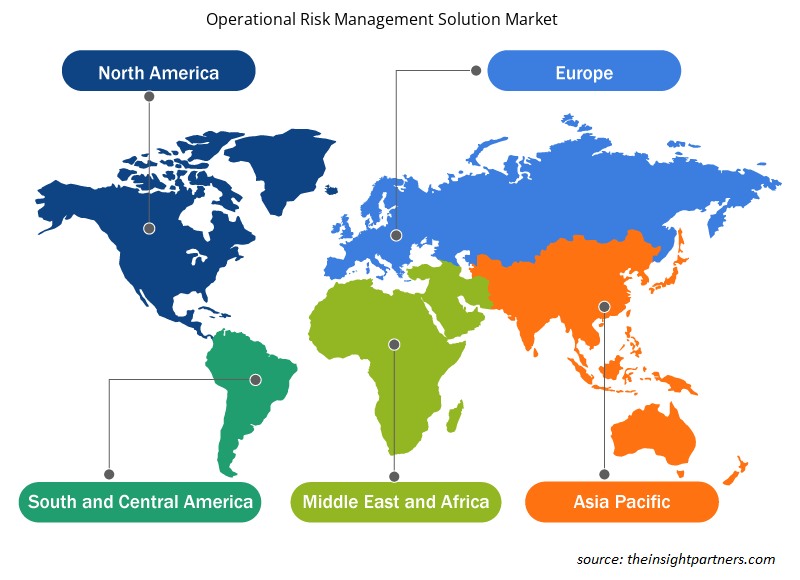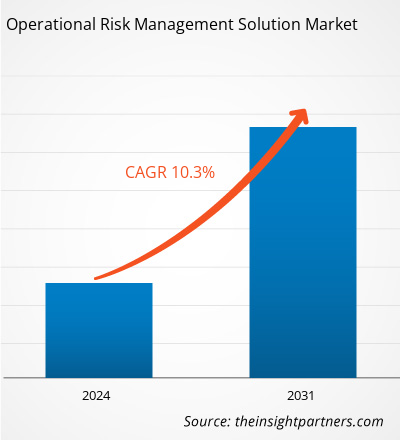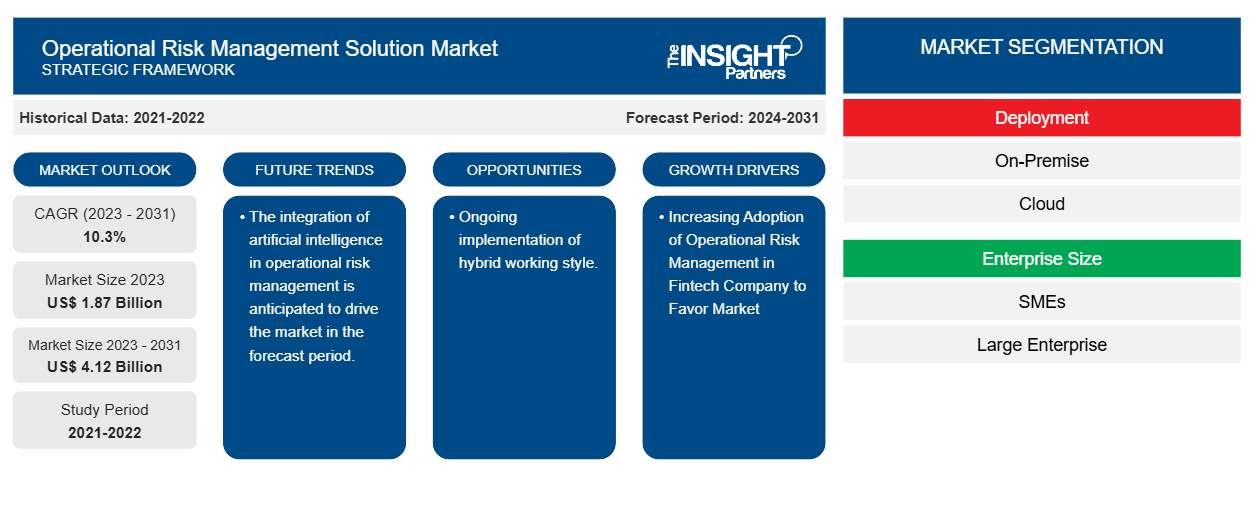من المتوقع أن يصل حجم سوق حلول إدارة المخاطر التشغيلية إلى 4.12 مليار دولار أمريكي بحلول عام 2031 من 1.87 مليار دولار أمريكي في عام 2023. ومن المتوقع أن يسجل السوق معدل نمو سنوي مركب بنسبة 10.3٪ خلال الفترة 2023-2031. ومن المرجح أن يكون التبني المتزايد لإدارة المخاطر التشغيلية في شركات التكنولوجيا المالية وارتفاع حالات الهجمات الإلكترونية في مختلف المنظمات من المحركات والاتجاهات الرئيسية في سوق حلول إدارة المخاطر التشغيلية.
تحليل سوق حلول إدارة المخاطر التشغيلية
يشهد سوق إدارة المخاطر التشغيلية نموًا كبيرًا على مستوى العالم. ويعزى هذا النمو إلى زيادة اعتماد إدارة المخاطر التشغيلية في شركات التكنولوجيا المالية وارتفاع حالات الهجمات الإلكترونية في مختلف المنظمات. علاوة على ذلك، من المتوقع أن يوفر التنفيذ المستمر لأنماط العمل الهجينة ودمج الذكاء الاصطناعي في إدارة المخاطر التشغيلية فرصًا كبيرة لسوق إدارة المخاطر التشغيلية في السنوات القادمة.
نظرة عامة على سوق حلول إدارة المخاطر التشغيلية
إن إدارة المخاطر التشغيلية هي عملية تشمل تقييم المخاطر واتخاذ القرارات وتنفيذ إجراءات التحكم في المخاطر للحد من مثل هذه التهديدات إلى المستويات المناسبة. إن إدارة المخاطر التشغيلية الموجهة إلى جميع القطاعات والصناعات، بما في ذلك المخاطر التشغيلية للبنوك والخدمات المالية، سوف تختلف عن المخاطر التشغيلية لمنشأة التصنيع. وفي نهاية المطاف، هناك حاجة إلى عملية قوية لإدارة المخاطر التشغيلية لأي منظمة لتجنب المشكلات الكارثية المحتملة وضمان استمرارية العمل.
قم بتخصيص هذا التقرير ليناسب متطلباتك
ستحصل على تخصيص لأي تقرير - مجانًا - بما في ذلك أجزاء من هذا التقرير، أو تحليل على مستوى الدولة، وحزمة بيانات Excel، بالإضافة إلى الاستفادة من العروض والخصومات الرائعة للشركات الناشئة والجامعات
-
احصل على أهم اتجاهات السوق الرئيسية لهذا التقرير.ستتضمن هذه العينة المجانية تحليلاً للبيانات، بدءًا من اتجاهات السوق وحتى التقديرات والتوقعات.
محركات وفرص سوق حلول إدارة المخاطر التشغيلية
زيادة اعتماد إدارة المخاطر التشغيلية في شركات التكنولوجيا المالية لصالح السوق
إن التبني المتزايد لإدارة المخاطر التشغيلية في شركات التكنولوجيا المالية هو في الواقع محرك السوق. تتوسع تكنولوجيا التمويل والصناعات بوتيرة سريعة، وكذلك عدد الشركات في الصناعة. تواجه شركات التكنولوجيا المالية احتياجات تنظيمية صارمة. ومع نمو عدد الشركات، يزداد الطلب على الامتثال واللوائح. علاوة على ذلك، تشتمل شركات التكنولوجيا المالية على بيانات مالية مختلفة بمعلومات حساسة، ولا يمكن اختراق هذه البيانات. يساعد حل إدارة المخاطر التشغيلية هنا ويمنع اختراق بيانات شركات التكنولوجيا المالية . وبالتالي، بالنظر إلى المعايير المذكورة أعلاه، فإن التبني المتزايد لإدارة المخاطر التشغيلية في شركات التكنولوجيا المالية هو محرك نمو سوق حلول إدارة المخاطر التشغيلية.
التنفيذ المستمر لأسلوب العمل الهجين.
من المتوقع أن يحمل التنفيذ الجاري لأسلوب العمل الهجين العديد من الفرص للسوق. تعتمد بيئة العمل الهجين على بنية تحتية معقدة وتحتاج إلى بنية تحتية قوية لتكنولوجيا المعلومات لإدارة الموظفين الذين يعملون عن بُعد والموظفين الذين يعملون في المكاتب. علاوة على ذلك، تستمر الجرائم الإلكترونية في النمو في التعقيد، ويجب على الشركات التي تتبنى نموذج العمل الهجين أن تحافظ على يقظتها مع وجود ضوابط قوية تحيط بأمن البيانات. تنطوي نماذج العمل الهجين على مخاطر مثل معايير الأمن السيبراني المتراخية، والاحتفاظ بالموظفين، وغير ذلك الكثير. توفر حلول إدارة المخاطر التشغيلية الوقاية من هذه المخاطر. وبالتالي، بالنظر إلى المعايير المذكورة أعلاه، من المتوقع أن يحمل التنفيذ الجاري لأسلوب العمل الهجين العديد من الفرص للسوق.
تقرير تحليل تجزئة سوق حلول إدارة المخاطر التشغيلية
إن القطاعات الرئيسية التي ساهمت في استخلاص تحليل سوق حلول إدارة المخاطر التشغيلية هي النشر وحجم المؤسسة.
- بناءً على النشر، ينقسم سوق حلول إدارة المخاطر التشغيلية إلى حلول محلية وحلول سحابية. ومن المتوقع أن يستحوذ قطاع الحلول المحلية على حصة سوقية كبيرة خلال فترة التوقعات.
- بناءً على حجم المؤسسة، يتم تقسيم سوق حلول إدارة المخاطر التشغيلية إلى الشركات الصغيرة والمتوسطة الحجم والشركات الكبيرة. ومن المتوقع أن تحظى شريحة الشركات الصغيرة والمتوسطة الحجم بحصة سوقية كبيرة خلال فترة التوقعات.
تحليل حصة سوق حلول إدارة المخاطر التشغيلية حسب المنطقة الجغرافية
ينقسم النطاق الجغرافي لتقرير سوق حلول إدارة المخاطر التشغيلية بشكل أساسي إلى خمس مناطق: أمريكا الشمالية، ومنطقة آسيا والمحيط الهادئ، وأوروبا، والشرق الأوسط وأفريقيا، وأمريكا الجنوبية والوسطى.
سيطرت أمريكا الشمالية على سوق حلول إدارة المخاطر التشغيلية. ينقسم سوق أمريكا الشمالية إلى الولايات المتحدة وكندا والمكسيك. يشهد السوق نموًا كبيرًا في المناطق. يُعزى هذا النمو إلى زيادة بيئة العمل الهجينة في المنطقة. أدت اتجاهات تبني التكنولوجيا العالية في مختلف الصناعات في منطقة أمريكا الشمالية إلى تغذية نمو سوق حلول إدارة المخاطر التشغيلية. ومن المتوقع أن تؤدي عوامل مثل زيادة اعتماد الأدوات الرقمية والإنفاق التكنولوجي العالي من قبل الوكالات الحكومية إلى دفع نمو سوق حلول إدارة المخاطر التشغيلية في أمريكا الشمالية.
علاوة على ذلك، فإن التركيز القوي على البحث والتطوير في الاقتصادات المتقدمة في الولايات المتحدة وكندا يجبر اللاعبين في أمريكا الشمالية على جلب حلول متقدمة تقنيًا إلى السوق. بالإضافة إلى ذلك، تمتلك الولايات المتحدة عددًا كبيرًا من اللاعبين في سوق حلول إدارة المخاطر التشغيلية الذين يركزون بشكل متزايد على تطوير حلول مبتكرة. تساهم كل هذه العوامل في نمو سوق حلول إدارة المخاطر التشغيلية في المنطقة.
رؤى إقليمية حول سوق حلول إدارة المخاطر التشغيلية
لقد قام المحللون في Insight Partners بشرح الاتجاهات والعوامل الإقليمية المؤثرة على سوق حلول إدارة المخاطر التشغيلية طوال فترة التوقعات بشكل شامل. يناقش هذا القسم أيضًا قطاعات سوق حلول إدارة المخاطر التشغيلية والجغرافيا في جميع أنحاء أمريكا الشمالية وأوروبا ومنطقة آسيا والمحيط الهادئ والشرق الأوسط وأفريقيا وأمريكا الجنوبية والوسطى.

- احصل على البيانات الإقليمية المحددة لسوق حلول إدارة المخاطر التشغيلية
نطاق تقرير سوق حلول إدارة المخاطر التشغيلية
| سمة التقرير | تفاصيل |
|---|---|
| حجم السوق في عام 2023 | 1.87 مليار دولار أمريكي |
| حجم السوق بحلول عام 2031 | 4.12 مليار دولار أمريكي |
| معدل النمو السنوي المركب العالمي (2023 - 2031) | 10.3% |
| البيانات التاريخية | 2021-2022 |
| فترة التنبؤ | 2024-2031 |
| القطاعات المغطاة |
حسب النشر
|
| المناطق والدول المغطاة |
أمريكا الشمالية
|
| قادة السوق وملفات تعريف الشركات الرئيسية |
|
كثافة اللاعبين في سوق حلول إدارة المخاطر التشغيلية: فهم تأثيرها على ديناميكيات الأعمال
يشهد سوق حلول إدارة المخاطر التشغيلية نموًا سريعًا، مدفوعًا بالطلب المتزايد من المستخدم النهائي بسبب عوامل مثل تفضيلات المستهلكين المتطورة والتقدم التكنولوجي والوعي المتزايد بفوائد المنتج. ومع ارتفاع الطلب، تعمل الشركات على توسيع عروضها والابتكار لتلبية احتياجات المستهلكين والاستفادة من الاتجاهات الناشئة، مما يؤدي إلى زيادة نمو السوق.
تشير كثافة اللاعبين في السوق إلى توزيع الشركات أو المؤسسات العاملة في سوق أو صناعة معينة. وهي تشير إلى عدد المنافسين (اللاعبين في السوق) الموجودين في مساحة سوق معينة نسبة إلى حجمها أو قيمتها السوقية الإجمالية.
الشركات الرئيسية العاملة في سوق حلول إدارة المخاطر التشغيلية هي:
- شركة أدابت آي تي القابضة المحدودة
- متريكستريم
- أمن RSA
- شركة تي بي اس سي او المحدودة
- ساب اس اي
- شركة شل الدولية
إخلاء المسؤولية : الشركات المذكورة أعلاه ليست مرتبة بأي ترتيب معين.

- احصل على نظرة عامة على أهم اللاعبين الرئيسيين في سوق حلول إدارة المخاطر التشغيلية
أخبار السوق والتطورات الأخيرة في مجال حلول إدارة المخاطر التشغيلية
يتم تقييم سوق حلول إدارة المخاطر التشغيلية من خلال جمع البيانات النوعية والكمية بعد البحث الأولي والثانوي، والتي تتضمن منشورات الشركات المهمة وبيانات الجمعيات وقواعد البيانات. فيما يلي بعض التطورات في سوق حلول إدارة المخاطر التشغيلية:
- أعلنت هيئة التنظيم الاحترازي الأسترالية (APRA) عن الانتهاء من المعيار الاحترازي CPS 230 لإدارة المخاطر التشغيلية (CPS 230). ووفقًا لـ APRA، يهدف CPS 230 إلى تعزيز قدرة الكيانات الخاضعة لتنظيم APRA على إدارة المخاطر التشغيلية ومعالجة الاضطرابات التجارية. (المصدر: موقع شركة APRA على الويب، يوليو 2023)
- أطلقت شركة تاتا للخدمات الاستشارية (TCS) حلاً مرنًا وبديهيًا لمراقبة المخاطر للتجارب السريرية، مما يتيح اتخاذ قرارات ذكية وزيادة الامتثال وتحسين فعالية الدراسة. (المصدر: موقع شركة TCS على الويب، أبريل 2022)
تقرير سوق حلول إدارة المخاطر التشغيلية والتغطية والنتائج المتوقعة
يقدم تقرير "حجم سوق حلول إدارة المخاطر التشغيلية والتوقعات (2021-2031)" تحليلاً مفصلاً للسوق يغطي المجالات التالية:
- حجم سوق حلول إدارة المخاطر التشغيلية والتوقعات على المستويات العالمية والإقليمية والوطنية لجميع قطاعات السوق الرئيسية التي يغطيها النطاق
- اتجاهات سوق حلول إدارة المخاطر التشغيلية بالإضافة إلى ديناميكيات السوق مثل المحركات والقيود والفرص الرئيسية
- تحليل مفصل لقوى PEST/Porter الخمس وSWOT
- تحليل سوق حلول إدارة المخاطر التشغيلية الذي يغطي اتجاهات السوق الرئيسية والإطار العالمي والإقليمي والجهات الفاعلة الرئيسية واللوائح والتطورات الأخيرة في السوق
- تحليل المشهد الصناعي والمنافسة الذي يغطي تركيز السوق، وتحليل خريطة الحرارة، واللاعبين البارزين، والتطورات الأخيرة لسوق حلول إدارة المخاطر التشغيلية
- ملفات تعريف الشركة التفصيلية
- التحليل التاريخي (سنتان)، سنة الأساس، التوقعات (7 سنوات) مع معدل النمو السنوي المركب
- تحليل PEST و SWOT
- حجم السوق والقيمة / الحجم - عالمي، إقليمي، بلد
- الصناعة والمنافسة
- مجموعة بيانات إكسل
التقارير الحديثة
تقارير ذات صلة
شهادات العملاء
سبب الشراء
- اتخاذ قرارات مدروسة
- فهم ديناميكيات السوق
- تحليل المنافسة
- رؤى العملاء
- توقعات السوق
- تخفيف المخاطر
- التخطيط الاستراتيجي
- مبررات الاستثمار
- تحديد الأسواق الناشئة
- تحسين استراتيجيات التسويق
- تعزيز الكفاءة التشغيلية
- مواكبة التوجهات التنظيمية























 احصل على عينة مجانية ل - سوق حلول إدارة المخاطر التشغيلية
احصل على عينة مجانية ل - سوق حلول إدارة المخاطر التشغيلية